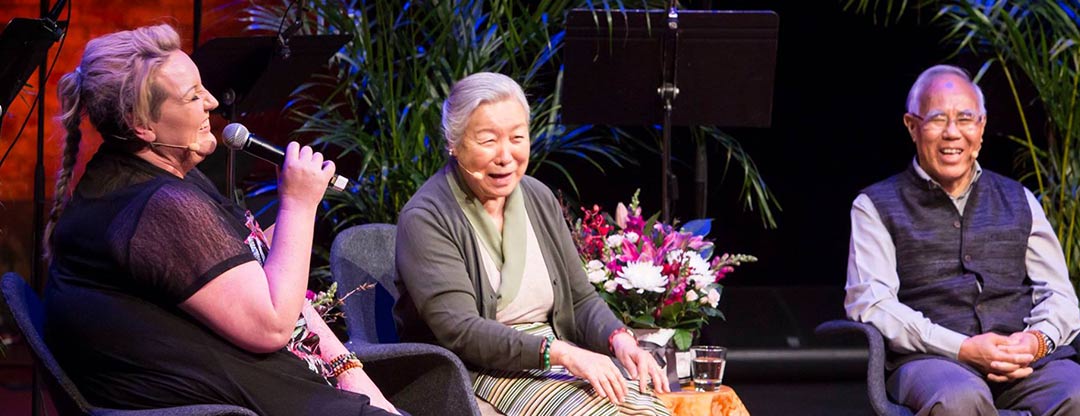
The gentle steeliness of Ama Jetsun Pema
By ATC member Rudrani Tooth
Ama Jetsun Pema, fondly called ‘Gangchen Amala’ (Mother of Tibet) has a steely gentleness that fills the eagerly packed auditorium. It is opening night of the Festival of Tibet and a palpable excitement spikes the air. The applause fades, Ama Jetsun Pema, centre stage, looks up acknowledging the crowd as she sits between entertainer and Buddhist author, Meshel Laurie, and her husband, Tenpa Tsering.
We learn Tenzin Choegyal, the Festival Director and musician, was educated in Dharamsala TCV (Tibetan Children Villages). To Tenzin, Ama Jetsun Pema is his second mother and his story is one of 52,000 children’s stories – all the refugee children Ama la provided homes for, now scattered like seeds for the future around the world.
Ama Jetsun Pema’s irrepressible laugh sends shivers up my spine, it echoes that of her highly revered older brother, HH the Dalai Lama. At only 24, after the death of her older sister, His Holiness requested Ama la assume responsibility for the refugee children flooding out of Tibet into Dharamsala. In 50 years she didn’t flinch or look away. She persevered. Today Ama la is responsible for establishing 10 residential schools, 17 day schools, 3 vocational training institutes, 3 hostels for college students and 1 college, spread across India.
I hear her gentleness when she confides, “the children now call me Mola (grandmother) rather than Ama la (mother). Far from taking credit for her extraordinary achievements she credits the children, “they help each other. Bonded by the mental and physical suffering they’ve been through.”
Meshel Laurie chortles in disbelief with an anecdote of her twins fighting. Ama la’s eyes fire up and I see a glimmer of the uncompromising steeliness of this woman who was the first female Kalon (Cabinet Minister), determined Tibetan children’s and women’s advocate and UNESCO medal winner. “There are not many fights amongst the children (in the TCVs). When I watch from my office there is always a peace maker amongst them. It is the Tibetan culture of kindness and compassion nurtured in all our TCVs.”
There is something undeniably special about Ama la. I saw it when she arrived, greeting Festival organizers, talking to stall holders. I saw it reflected in the eyes of the audience and I feel it now in my heart weeks after the Festival. The sweet and steely gentleness that made every Tibetan refugee child, “my child.” The steely determination that listened; “there was nothing worse than having to listen to their cries of pain, especially as we could do nothing to alleviate their suffering.. we were so short of resources…Tibetans were in rags, children were crying and trembling with cold, and the women seemed stunned by the weight of their misfortune.”
As I write this I am reminded again of Ama la’s memoir, “Tibet : My Story”. But it is not so much the words I remember, but her gentle peace that rather than diminishing in the face of Tibet’s struggles is stronger today. I wonder how her Tibetan seeds; her 52,000 children and the future of Tibet will blossom in foreign soils.
I wonder how we Westerners can help.
